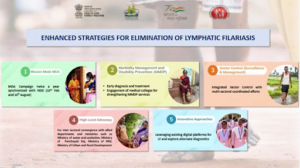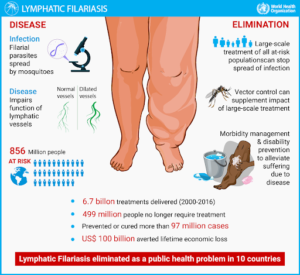In news- Ministry of Health & Family Welfare launched a nationwide Mass Drug Administration (MDA) campaign to Eliminate Lymphatic Filariasis (LF).
About the campaign-
- It is aimed at ending disease transmission through the door-to-door administration of anti-filarial drugs, especially in 10 filaria affected states.
- This launch comes a month after the program received resounding support from the Hon’ble Health Minister to eliminate Filariasis by 2027, three years ahead of the global target.
- High-burden districts in Bihar, Chhattisgarh, Jharkhand, Maharashtra, Uttar Pradesh, West Bengal, Karnataka, Odisha, Madhya Pradesh, and Andhra Pradesh jointly launched the campaign.
- India has ramped up efforts in eliminating Lymphatic Filariasis a Vector Borne Disease caused by Culex mosquitoes which causes disability well ahead of global targets to safeguard communities from disability, social and economic insecurity.
- The Government of India has already unveiled a renewed five-pronged strategy for elimination of LF as shown in the figure below.

What is Filariasis?
- Lymphatic filariasis, commonly known as elephantiasis, is a neglected tropical disease.
- Infection occurs when filarial parasites are transmitted to humans through mosquitoes. Infection is usually acquired in childhood causing hidden damage to the lymphatic system.
- It impairs the lymphatic system and can lead to the abnormal enlargement of body parts, causing pain, severe disability and social stigma.
- The painful and profoundly disfiguring visible manifestations of the disease, lymphoedema, elephantiasis and scrotal swelling occur later in life and can lead to permanent disability.
- These patients are not only physically disabled, but suffer mental, social and financial losses contributing to stigma and poverty.
- Lymphatic filariasis is caused by infection with parasites classified as nematodes (roundworms) of the family Filariodidea. There are 3 types of these thread-like filarial worms:
- Wuchereria bancrofti, which is responsible for 90% of the cases
- Brugia malayi, which causes most of the remainder of the cases
- Brugia timori, which also causes the disease.
- Adult worms nest in the lymphatic vessels and disrupt the normal function of the lymphatic system. The worms can live for approximately 6–8 years and, during their lifetime, produce millions of microfilariae (immature larvae) that circulate in the blood.
- Mosquitoes are infected with microfilariae by ingesting blood when biting an infected host. Microfilariae mature into infective larvae within the mosquito.
- When infected mosquitoes bite people, mature parasite larvae are deposited on the skin from where they can enter the body. The larvae then migrate to the lymphatic vessels where they develop into adult worms, thus continuing a cycle of transmission.
- Lymphatic filariasis is transmitted by different types of mosquitoes for example by the Culex mosquito, widespread across urban and semi-urban areas, Anopheles, mainly found in rural areas, and Aedes, mainly in endemic islands in the Pacific.
- Lymphatic filariasis infection involves asymptomatic, acute, and chronic conditions.
- The majority of infections are asymptomatic, showing no external signs of infection while contributing to transmission of the parasite.
- These asymptomatic infections still cause damage to the lymphatic system and the kidneys and alter the body’s immune system.

















